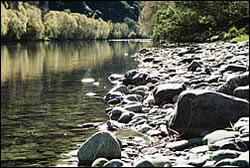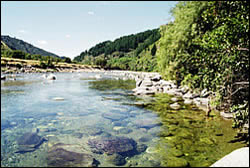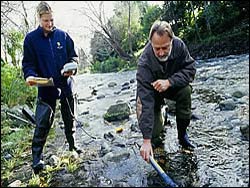Stream health – invertebrates
Research Status: Ongoing |
Clear waters of Motueka River |
Introduction
How healthy is the Motueka River? To answer this question it is necessary to examine the current health of the river system and its tributaries. In addition it is also important to look at the relationship of river health with land use and geology.
Research Approach
As part of the catchment-wide monitoring effort stream health has also been assessed, largely to provide a baseline against which future trends can be assessed.
The effects of land use were measured by comparisons among pastoral, exotic forest and native forest sites on Moutere gravel and Separation Point granite terrains.
TDC continues to monitor the health of invertebrates at five of the medium to small waterways in the catchment.
Research Results
According to the stream invertebrate communities recently studied at 46 sampling sites throughout the catchment, the majority of the Motueka River ecosystem is in good health.
Sites in the headwaters are particularly healthy, while there are some concerns in the lower tributaries. Streams draining ultramafic geology in the headwaters of the catchment are characterised by low invertebrate densities and diversity, but the few species that were found are typical of clean mountain streams. Invertebrate communities in streams draining native forest on the other geological types in the catchment (Moutere gravel, Separation Point Granite, hard sedimentary rock, and marble) appeared to be relatively similar to each other and were also indicative of healthy ecosystems.
Native forest sites were consistently healthier than pastoral streams. Interestingly, exotic forest streams draining Separation Point granite had healthy invertebrate communities (similar to native forest), while exotic forest streams draining Moutere Gravels were more degraded and similar to pastoral streams. To some extent this is the opposite of what we expected given the concerns about erosion from Separation Point granites. However, significant amounts of fine clays can be washed into Moutere gravel streams after rainfall and may affect stream invertebrate communities. Erosion of granite tends to produce large quantities of coarse sand, but perhaps sand is not as damaging to invertebrate communities as fine clay.
An alternative explanation for these results relates to low flows at the study sites prior to our sampling. Separation Point granite acts like a sponge during rainfall, slowly releasing water and maintaining stream flows even after long dry periods. In contrast, Moutere gravels store little water and streams draining these areas of the catchment often dry up. The difference in water storage capacity between these geologies is particularly evident in areas covered in exotic forest which are known to reduce water yields even further.
Land use appears to have the major influence on the structure of macroinvertebrate communities in the Motueka Catchment. However, in some cases the magnitude of land use impacts can be influenced by the interaction between land use and geology. Therefore, the geological features of a catchment should therefore be an important consideration for assessing the impacts of future land management scenarios on streams and rivers.
 |
 |
Wangapeka River |
Measuring dissolved oxygen |
Recent Publications
Recent Presentations
BMPs, BEPs and Guidelines
| Title | Description |
| Stormwater – swales | Swales are vegetated areas used in place of curbs or paved gutters to transport stormwater runoff. T...More » |
| Information on key sustainable farming topics |
From website: A table designed to help find information/publications that are related to whole...More » |
| Managing Waterways on Farms: A guide to sustainable water and riparian management in rural New Zealand |
From website: This publication provides background information about the sources, causes and p...More » |
| Microbiological Water Quality Guidelines for Marine and Freshwater Recreational Areas |
From guide: The Microbiological Water Quality Guidelines for Marine and Freshwater Recreationa...More » |
| Culvert and Bridge Construction Guidelines for Farmers |
From guide: These guidelines provide dairy farmers considering constructing a culvert or bridg...More » |
| Culvert Crossings | A guide to the proper construction of culvert stream–crossings. One in a series of land manag...More » |
| Stormwater Best Practice Guide |
From website: This guide is for Audit purposes to show that Council, and more particularly the...More » |
| Sustainable Options: Farm Tracks––planning, construction and maintenance | A guide to planning, constructing and maintenance of effective farm tracks. One in a series of land...More » |
| Clean Streams: A Guide to Managing Waterways on Tasman – Marlborough Farms |
From booklet: This booklet provides information about how to manage waterways to improve water...More » |
| The National Standard for Environmental Certification of well–managed Plantation Forests in New Zealand | Outlines the National Standard for environmental certification of plantation forests. It provides f...More » |
Primary Contacts:

|
Trevor James
Email |
Institute Tasman District Council |
Expertise Water Quality and Aquatic Ecology |
|
|
Karen Shearer
Email |
Institute Cawthron Institute |
Expertise Freshwater biologist. Macroinvertebrate sample processing, biomonitoring |

|
Roger Young
Email Phone: (03) 548 2319 Fax: (03) 546 9464 |
Institute Cawthron Institute |
Expertise Land/water interactions, water quality, fisheries, river health |